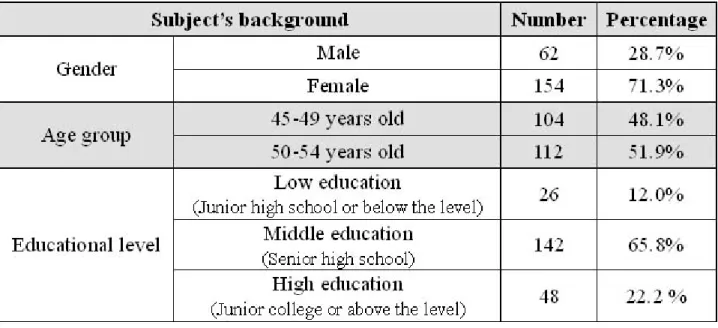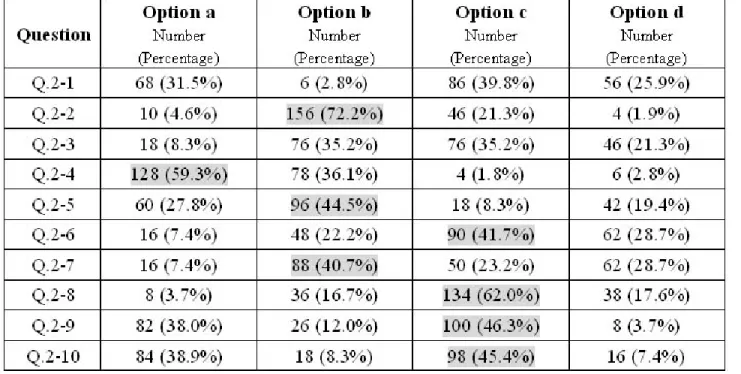Research Express@NCKU - Articles Digest
Research Express@NCKU Volume 5 Issue 3 - July 18, 2008 [ http://research.ncku.edu.tw/re/articles/e/20080718/2.html ]
A usability study on human–computer
interface for middle-aged learners
Shih-Wen Hsiao
*, Jyh-Rong Chou
Department of Industrial Design, National Cheng Kung University Email: swhsiao@mail.ncku.edu.tw
Computers in Human Behavior, 2007, 23, 2040-2063
"U
sability” is a well-known and well-defined concept in human-computer interaction (HCI) research, referring to the extent to which the user and the system can “communicate” clearly and withoutmisunderstanding through the interface. Usability evaluation using testing, inspection, or inquiry methods is widely employed in the human-computer interface area. During the past, a wide variety of usability evaluation tools has been proposed in which questionnaires are one of the
inquiry-based techniques generally used in usability research. A well-designed questionnaire can give valuable feedback from the user point of view, and also can assist researchers in collecting useful information. Besides, data analysis plays an important role in usability studies. Given the user-centered nature that computer interfaces should be used by specified users to achieve specified goals in a specified context of use, data should be reasonably representative of the population involved in the research. The present study focuses on a usability analysis of human-computer interface for middle-aged learners in Taiwan. In this study, we use a computer-training course associated with a questionnaire survey, correlation analysis, and the grey relational model to derive some user characteristics and learning behavior in terms of middle-aged computer learners.
In this study, the grey relational model is employed to aid in deriving certain learning behavior for the middle-aged computer learners. The grey relational model can be summarized as follows:
Step 1. Let the reference sequence be .
Step 2. Denote the m sequences to be compared by , . Step 3. The grey relational coefficient between and at point k can be expressed as:
(1) where
represents the distinguishing coefficient.
;
Step 4. The grey relational grade is derived as below: (2)
The grey relational grade, , represents what degree of influence the sequence exerts on the reference sequence , and we use the relation to decide the quantity of adjustment. In other words, the reference sequence can provide some useful information about the variation of data points from other 1 of 4
Research Express@NCKU - Articles Digest
similar sequences. By analysis of the grey relational grade, we can understand which factors will crucially affect reference factors.
Based on a cohort analysis, the usability study for middle-aged computer learners contained two phases: (1) an elementary computer-training task, and (2) a usability analysis of the human-computer interface. The first phase was a short-term computer-training course provided to middle-aged people who had no previous computer experience and were presently unemployed. The purpose of phase 1 was to have subjects use available computers. In the second phase, we analyzed the usability of computer interfaces in terms of these unemployed middle-aged learners. A total of 216 subjects were selected from the trainees of 12 terms (2–3 weeks per term) of a computer-training program in which they participated in this experimental study. The participants were qualified unemployed adults who involuntarily left their jobs, and the age of the subjects ranged from 45 to 54 years (i.e. “middle-aged” adults). To ensure experimental variables being equitable and objective, the overall participants were required to have had no computer experience before the experiment. Gender, age group, and educational level classified the subjects’ backgrounds, respectively, as shown in Table 1.
Table 1. Summary of subjects’ backgrounds
In order to analyze the usability of computer interfaces for the experimental participants who had no computer literacy before, a 36-hour training course was provided for the subjects who learned elementary computer skills. The short-term training course, financially supported by the Bureau of Employment and Vocational Training, is the most important part of the “Assisting Unemployed Persons to Participate Digital Capability Enhancement Training Program”. There were three units contained in the elementary course: (1) Windows operating system (12 hrs), (2) Microsoft Word (18 hrs), and (3) Internet and electronic mail (6 hrs). Referring to related guidelines, standards, and evaluation methods concerning the usability of human-computer interface, we formulated a questionnaire to test the experimental subjects. The questionnaire was provided to the subjects after they had completed the short-term training course. It comprised three parts: (1) personal details about the subject’s learning background, (2) an adaptability analysis concerning the use of computer hardware and software
interfaces, and (3) an acceptability inquiry in terms of the learners’ computer experience. In Part 1 of the questionnaire, participants gave their personal details including gender, age range, and level of
education. Ten closed-ended questions were presented in Part 2 of the questionnaire, and each question contained four alternative answers with one only choice. In Part 3 of the questionnaire, ten closed-ended 2 of 4
Research Express@NCKU - Articles Digest
questions were given and each question had to be rated on the basis of five attitude scales: strongly disagree, disagree, no comment, agree, and strongly agree.
In addition to general statistics of subjects’ responses by questionnaire survey, we used a correlation analysis to classify the relationships between subjects’ learning backgrounds and the adaptability options regarding the use of computer hardware and software interfaces. Moreover, we employed the grey relational model associated with interaction matrixes to analyze subjects’ responses via the
acceptability inquiry. The correlation analysis helps us to identify certain user characteristics in terms of the unemployed middle-aged learners, and the grey relational analysis assists us in deriving their learning behavior. The responses to main survey questions concerning the adaptability analysis are statistically classified as shown in Table 2.
Table 2. Responses to main survey questions concerning the adaptability analysis
The statistics of subjects’ responses to main survey questions concerning the acceptability inquiry are classified as shown in Table 3. Table 2 and Table 3 express the numbers and percentages that the overall respondents responded to the main survey questions.
Table 3. Responses to main survey questions concerning the acceptability inquiry
Research Express@NCKU - Articles Digest
From analyzing subjects’ responses to the survey questions, the keyboard is the most difficult-to-use hardware device which involves maintaining a neutral wrist posture without arm support to hover or float over the keyboard while typing. Besides, most middle-aged learners cannot adapt themselves to keep a static posture for a long working period of time while using computers. Since present software interface design is considered to be functionally incomprehensible, it is difficult for middle-aged learners to familiarize themselves with the use of computer software. Although middle-aged learners have
perceived that having sufficient computer literacy is very beneficial to them, they do not entirely consider that they are able to perform well in learning and manipulating computers. On the whole, the usability of present mouse and monitor devices is preferable to that of the keyboard device and a Windows-based software interface in terms of middle-aged learners.
Further analyzing the differences of middle-aged learners’ using characteristics, we found that mouse usage has much more distinction among the three correlates: gender, age group, and educational level. Educational level is the major factor influencing middle-aged learners’ use of computer interfaces, while gender and age group are relatively insignificant factors. Regarding the learners’ learning behavior, more males than females were found to exhibit the phenomenon of computerphobia. To unemployed middle-aged learners, the younger age group shows lower anxiety and hold more positive attitudes toward computer learning than the older age one. Moreover, the higher education learners hold much more positive expectation toward their computer learning while the lower education learners pay more attention to their learning capability and deficiency.

